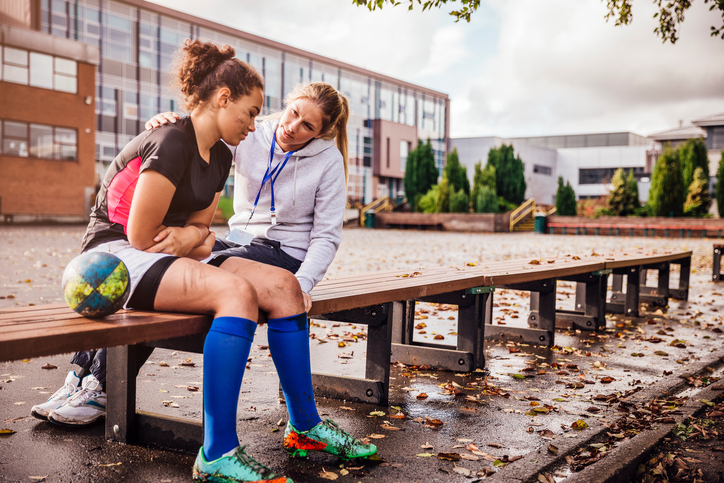By Peter Dzendrowskyj
This is Part 3 of the human factors in sports medicine blog. If you haven’t already done so, read Part 1 and Part 2 first! In this blog, I’ll go into the different human factors needed in clinic vs on the pitch.
Communicating in clinic
An unclear message on the treatment and rehabilitation of common extensor tendinopathy may delay a return to play by several months. Or, more seriously, if the prognosis and differential diagnoses of potential stress fractures, concussion or spinal stenosis are misunderstood, there may be more significant and catastrophic complications. Being able to gauge the level of understanding and also the drive for rehabilitation plays a role in overall outcome – this skill is known as “emotional intelligence”. Whilst lack of these skills may not make any immediate and obvious change to a patient’s clinical status, it does make a difference in the long term. A lack of these skills is the leading cause of patient complaints in the USA – with “a lack of listening” often cited as the major complaint toward the doctor concerned (3). No matter how busy the clinic is, or how difficult the patient, the patient is the doctor’s primary concern for the time they are in the consultation room and the patient deserves the best clinical care possible.
Part of being adept in human factors is also being able to recognise in oneself when one’s professional self is not optimal. No matter how many times people deny it, personal and everyday stressors are brought into work (e.g., personal, financial, medical). Being able to recognise this – set aside a few minutes to settle a cluttered mind for example – can make all the difference between a successful or a disastrous consultation. Being able to recognise this in others – patients certainly, but more importantly, work colleagues – can also help to create a more fulfilling work environment.
Communicating on the pitch / during competition
If a rare event such as a pitchside cardiac arrest or – less rare – collapse during competition occurs, there is a real need to be able to organise, optimise and effectively manage the critical situation professionally, ensuring that the team operates at full capacity. Using simple styles of communication (such as closed loop communication / using individual’s names / a calm, clear vocal tone when issuing instructions etc.) can calm the team down and allow individuals to work within their knowledge base without panic. The lack of a clearly identifiable leader and the lack of clear, concise instructions from that leader are two of the most important factors that may differentiate between success and failure of a critical incident (4). By default, the leader is usually the doctor on the scene, and he or she must be familiar with the basics of leadership and communication to ensure the best possible outcome may prevail.
Lack of communication and poor information sharing between team members during competition can also lead to disastrous results (5,6). For example, if personal physiotherapists or doctors to individual sportspeople do not share information regarding injuries or rehabilitation until a few days before competition, then suboptimal treatment options may occur. This can be particularly prevalent in competitions such as the Olympic and Commonwealth Games.
Being aware of such vital skills as our ability to interact with other members of a team, to organise and plan appropriately and to alter those plans according to an ever-changing clinical picture is the first step in improving the functioning of our team as a whole. In addition, certain medical specialities (critical care, anaesthesia and surgery for example) all now teach human factors as part of post-graduate training. There are validated teaching methods for this (e.g., Non-technical skills for surgeons/ anaesthetists tools), which can be modified for sports medicine training (7,8). Categories that are taught and assessed are divided into:
- Situation awareness
- Decision making
- Communication and teamwork
- Leadership
These skills are called human factors for the very simple fact that all humans can – and should – be able to master them properly – and doctors should be at the forefront of ensuring their mastery of these skills are of the highest level, to ensure good clinical outcomes and optimal patient care.
***
Peter Dzendrowskyj is a dually accredited Intensivist and Anaesthetist who calls both UK and New Zealand home – although he has been working at Aspetar Hospital in Qatar for the past few years. He is actively involved in education and teaching. His particular interests are in the treatment of sepsis and burns, clinical teaching and education, medical simulation, human factors and clinical leadership. Email: peter.dzendrowskyj@aspetar.com
References
- Van Mook WNKA, Gorter SL, Kieboom W Castermans MGTH et al. Poor professionalism identified through investigation of unsolicited healthcare complaints. Postgraduate Medical Journal. Published online May 17, 2012 as 10.1136/postgradmedj-2011-130083
- Frengley R, Weller J, Torrie J, Dzendrowskyj P, Yee B, Paul A, Shulruf B, Henderson K, Hopley L. The effect of a simulation-based training intervention on the performance of established Critical Care Unit teams. Critical Care Medicine, 2011: 39; (12); 2605-11
- Onag Z, Tepeci M. Team Effectiveness in Sport Teams: The Effects of Team Cohesion, Intra Team Communication and Team Norms on Team Member Satisfaction and Intent to Remain. Procedia – Social and Behavioral Sciences, 2014: 150; 420 – 428
- Ekstrand J, Lundqvist D, Davison M, D’Hooghe M et al. Communication quality between the medical team and the head coach/manager is associated with injury burden and player availability in elite football clubs. Br J Sports Med 2019;53:304–308
- Fletcher G, McGeorge P, Flin R, Glavin R, Maran N. Anaesthetists’ non-technical skills (ANTS). Evaluation of a behavioural marker system. Br J Anaesth. 2003; 90; 580-588
- Yule S, Flin R, Maran N, Rowley DR, Youngston GG, Paterson-Brown S. Surgeons’ non-technical skills in the operating room: Reliability testing of the NOTSS behaviour rating system. World J Surgery 2008; 32; 548-556
